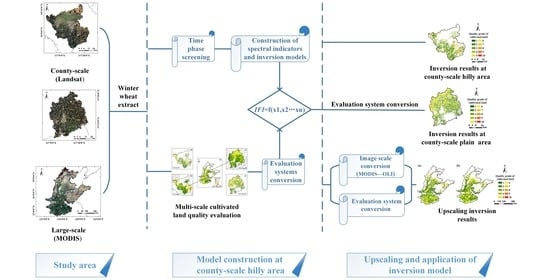Upscaling Remote Sensing Inversion Model of Wheat Field Cultivated Land Quality in the Huang-Huai-Hai Agricultural Region, China
Abstract
:1. Introduction
2. Materials and Methods
2.1. Study Area
2.2. Data Source and Preprocessing
2.3. Methods
2.3.1. CLQ Evaluation Based on GIS and Evaluation Systems Conversion
- (1)
- Wheat Field Information Extraction
- (2)
- CLQ Evaluation Based on GIS
- (3)
- Conversion of CLQ Evaluation Systems
2.3.2. Construction of CLQ Inversion Models at County-Scale
- (1)
- Selection of Optimal Time Phase for CLQ Inversion
- (2)
- Construction of CLQ Inversion Model at County-scale Hilly Area
- ①
- Construction and Screening of Characteristic Spectral Parameters
- ②
- Construction and Screening of Inversion Models
- (3)
- Promotion of CLQ Inversion Model at County-scale Plain Area
- (4)
- Verification of Inversion Model Accuracy
2.3.3. Upscaling Conversion of CLQ Inversion Model at Large-Scale
- (1)
- Upscaling Conversion of Remote Sensing Images
- (2)
- Upscaling Conversion of Evaluation Systems
- (3)
- Verification of Upscaling Inversion Accuracy
2.3.4. Spatio-Temporal Dynamic Analysis of Wheat Field Quantity and Quality
3. Results and Analysis
3.1. The Results of CLQ Evaluation and Conversion Models of Evaluation Systems
3.1.1. The Results of Wheat Field Extracted
3.1.2. The Results of CLQ Evaluation Based on GIS
3.1.3. Conversion Models of CLQ Evaluation Systems
3.2. CLQ Inversion Models at County-Scale
3.2.1. The Results of Time Phase Screening
3.2.2. CLQ Inversion Model at the County-Scale Hilly Area
- (1)
- Characteristic Spectral Parameters
- (2)
- CLQ Inversion Models
3.2.3. CLQ Inversion Model at the County-Scale Plain Area
3.2.4. Verification Results of Inversion Accuracy
3.3. The Results of Upscaling Conversion and Model Inversion
3.3.1. The Results of Images Upscaling Conversion
- (1)
- Reflectance Comparison between OLI and MODIS Bands
- (2)
- Image Upscaling Conversion Models
3.3.2. Upscaling Inversion Model at Large-Scale
3.3.3. Verification Results of Upscaling Inversion Accuracy
3.4. The Dynamic Analysis Results of Wheat Field Quantity and Quality
3.4.1. Wheat Field Quantity Change
3.4.2. Wheat Field Quality Change
4. Discussion
5. Conclusions
- (1)
- Conversion models of evaluation systems are Y = 1.021x − 4.989 (CMESA–B: from county-scale hilly area to county-scale plain area), Y = 0.801x + 16.925 (CMESA–C: from county-scale hilly area to large-scale hilly area), and Y = 0.959x + 3.458 (CMESC–D: from large-scale hilly area to large-scale plain area), with R2 > 0.942 and RMSE < 3.559, which can realize the CLQ connection in different regions and scales.
- (2)
- The booting stage is the best time for CLQ inversion. The BPNN model based on the combination index group (CI-BPNN) is the best inversion model, with R2 = 0.722 and RMSE = 4.661 (validation precision). The CI-BPNN and CI-BPNN-CMESA–B models have strong spatial universality and stability at county-scale hilly and plain areas. The maximum level area ratio difference between model inversion and conventional evaluation are 2.91% and 4.87%, respectively.
- (3)
- For image upscaling conversion, the reflectance conversion model of short-wave infrared 2 is cubic, and the others are quadratic. By converting images and evaluation systems, the upscaling inversion models are CI-BPNN-CMESA–C (hilly secondary zones) and CI-BPNN-CMESA–C-CMESC–D (plain secondary zones), with the maximum level area ratio difference being 1.60%, which has high prediction accuracy and spatial universality.
- (4)
- Since 2001, the wheat field area has been relatively stable, and the dynamic degree is between −5% and 5%. The wheat field quality has been steadily improved in the Huang-Huai-Hai region, with high-level lands increasing, low-level lands decreasing, and medium-level lands staying relatively stable.
Author Contributions
Funding
Institutional Review Board Statement
Informed Consent Statement
Data Availability Statement
Acknowledgments
Conflicts of Interest
References
- Mekonnen, M.; Abeje, T.; Addisu, S. Integrated watershed management on soil quality, crop productivity and climate change adaptation, dry highland of Northeast Ethiopia. Agric. Syst. 2021, 186, 102964. [Google Scholar] [CrossRef]
- Orhan, O. Land suitability determination for citrus cultivation using a GIS-based multi-criteria analysis in Mersin, Turkey. Comput. Electron. Agric. 2021, 190, 106433. [Google Scholar] [CrossRef]
- Khan, S.; Hanjra, M.A.; Mu, J.X. Water management and crop production for food security in China: A review. Agric. Water Manag. 2009, 96, 349–360. [Google Scholar] [CrossRef]
- Huang, K.; Liu, Z.; Yang, L.F. Evaluation of winter wheat productivity in Huang-Huai-Hai region by multi-year graded MODIS-NDVI. Trans. Chin. Soc. Agric. Eng. 2014, 30, 153–161. [Google Scholar] [CrossRef]
- Li, J.D.; Lei, H.M. Tracking the spatio-temporal change of planting area of winter wheat-summer maize cropping system in the North China Plain during 2001–2018. Comput Electron. Agric. 2021, 187, 106222. [Google Scholar] [CrossRef]
- Yang, Z.F.; Yu, T.; Hou, Q.Y.; Xia, X.Q.; Feng, H.Y.; Huang, C.L.; Wang, L.S.; Lv, Y.Y.; Zhang, M. Geochemical evaluation of land quality in China and its applications. J. Geochem Explor. 2014, 139, 122–135. [Google Scholar] [CrossRef]
- Raiesi, F.; Kabiri, V. Identification of soil quality indicators for assessing the effect of different tillage practices through a soil quality index in a semi-arid environment. Ecol. Indic. 2016, 71, 198–207. [Google Scholar] [CrossRef]
- Tashayo, B.; Honarbakhsh, A.; Azma, A.; Akbari, M. Combined fuzzy AHP–GIS for agricultural land suitability modeling for a watershed in southern Iran. Environ. Manag. 2020, 66, 364–376. [Google Scholar] [CrossRef]
- Zhang, B.; Zhang, Y.; Chen, D.; White, R.E.; Li, Y. A quantitative evaluation system of soil productivity for intensive agriculture in China. Geoderma 2004, 123, 319–331. [Google Scholar] [CrossRef]
- Weiss, M.; Jacob, F.; Duveiller, G. Remote sensing for agricultural applications: A meta-review. Remote Sens. Environ. 2020, 236, 111402. [Google Scholar] [CrossRef]
- Eilola, S.; Käyhkö, N.; Fagerholm, N. Lessons learned from participatory land use planning with high-resolution remote sensing images in Tanzania: Practitioners’ and participants’ perspectives. Land Use Policy 2021, 109, 105649. [Google Scholar] [CrossRef]
- Wu, J.; Li, Z.B.; Li, Y.H.; Zhao, G.X.; Li, C.G. Arable land fertility inversion based on vegetation index from TM image. J. Nat. Resour. 2015, 30, 1035–1046. [Google Scholar] [CrossRef]
- Fathizad, H.; Ardakani, M.A.H.; Heung, B.; Sodaiezadeh, H.; Rahmani, A.; Fathabadi, A.; Scholten, T.; Taghizadeh-Mehrjardi, R. Spatio-temporal dynamic of soil quality in the central Iranian desert modeled with machine learning and digital soil assessment techniques. Ecol. Indic. 2020, 18, 106736. [Google Scholar] [CrossRef]
- Binte Mostafiz, R.; Noguchi, R.; Ahamed, T. Agricultural Land Suitability Assessment Using Satellite Remote Sensing-Derived Soil-Vegetation Indices. Landing 2021, 10, 223. [Google Scholar] [CrossRef]
- Fang, L.N.; Song, J.P. Cultivated land quality assessment based on SPOT multispectral remote sensing image: A case study in Jimo City of Shandong Province. Prog. Geogr. 2008, 27, 71–78. [Google Scholar] [CrossRef]
- Xia, Z.Q.; Peng, Y.P.; Liu, S.S.; Liu, Z.H.; Wang, G.X.; Zhu, A.X.; Hu, Y.M. The Optimal Image Date Selection for Evaluating Cultivated Land Quality Based on Gaofen-1 Images. Sensors 2019, 19, 4937. [Google Scholar] [CrossRef] [Green Version]
- Zolekar, R.B.; Bhagat, V.S. Multi-criteria land suitability analysis for agriculture in hilly zone: Remote sensing and GIS approach. Comput. Electron. Agric. 2015, 118, 300–321. [Google Scholar] [CrossRef]
- Xu, W.Y.; Jin, J.X.; Jin, X.B.; Xiao, Y.Y.; Ren, J.; Liu, J.; Sun, R.; Zhou, Y.K. Analysis of changes and potential characteristics of cultivated land productivity based on MODIS EVI: A case study of Jiangsu Province, China. Remote Sens. 2019, 11, 2041. [Google Scholar] [CrossRef] [Green Version]
- Sciortino, M.; De Felice, M.; De Cecco, L.; Borfecchia, F. Remote sensing for monitoring and mapping Land Productivity in Italy: A rapid assessment methodology. Catena 2020, 188, 104375. [Google Scholar] [CrossRef]
- Yu, S.N.; Zhang, X.K.; Zhang, X.L.; Liu, H.J.; Qi, J.G.; Sun, Y.K. Detecting and Assessing Nondominant Farmland Area with Long-Term MODIS Time Series Images. Remote Sens. 2020, 12, 2441. [Google Scholar] [CrossRef]
- Verburg, P.H.; Chen, Y.Q. Multiscale characterization of land-use patterns in China. Ecosystems 2000, 3, 369–385. [Google Scholar] [CrossRef]
- Li, X.W.; Wang, Y.T. Prospects on future developments of quantitative remote sensing. Acta Geogr. Sin. 2013, 68, 1163–1169. [Google Scholar]
- Wu, H.; Tang, B.H.; Li, Z.L. Impact of nonlinearity and discontinuity on the spatial scaling effects of the leaf area index retrieved from remotely sensed data. Int. J. Remote Sens. 2013, 34, 3503–3519. [Google Scholar] [CrossRef]
- Van der Linden, S.; Rabe, A.; Held, M.; Jakimow, B.; Leitão, P.J.; Okujeni, A.; Schwieder, M.; Suess, S.; Hostert, P. The EnMAP-Box—A toolbox and application programming interface for EnMAP data processing. Remote Sens. 2015, 7, 11249. [Google Scholar] [CrossRef] [Green Version]
- Skakun, S.; Franch, B.; Vermote, E.; Roger, J.C.; Becker-Reshef, I.; Justice, C.; Kussul, N. Early season large-area winter crop mapping using MODIS NDVI data, growing degree days information and a Gaussian mixture model. Remote Sens. Environ. 2017, 195, 244–258. [Google Scholar] [CrossRef]
- General Administration of Quality Supervision, Inspection, Quarantine of the (AQSIQ), P.R.C., Standardization Administration of China (SAC). Cultivated Land Quality Grade (GB/T 33469-2016). 2016. Available online: https://www.chinesestandard.net/PDF/BOOK.aspx/GBT33469-2016 (accessed on 1 August 2021).
- Wang, Z.; Wang, G.; Zhang, G.; Wang, H.; Ren, T. Effects of land use types and environmental factors on spatial distribution of soil total nitrogen in a coalfield on the Loess Plateau, China. Soil Tillage Res. 2021, 211, 105027. [Google Scholar] [CrossRef]
- Xue, J.R.; Su, B.F. Significant remote sensing vegetation indices: A review of developments and applications. J. Sens. 2017, 2017, 1353691. [Google Scholar] [CrossRef] [Green Version]
- Zhang, N.; Hong, Y.; Qin, Q.M.; Zhu, L. Evaluation of the visible and shortwave infrared drought index in China. Int. J. Disaster Risk Sci. 2013, 4, 68–76. [Google Scholar] [CrossRef] [Green Version]
- Zheng, X.M.; Ding, Y.L.; Zhao, K.; Jiang, T.; Li, X.F.; Zhang, S.Y.; Li, Y.Y.; Wu, L.L.; Sun, J.; Ren, J.H.; et al. Estimation of Vegetation Water Content from Landsat 8 OLI Data. Spectrosc. Spectr. Anal. 2014, 34, 3385–3390. [Google Scholar]
- Wójtowicz, M.; Wójtowicz, A.; Piekarczyk, J. Application of remote sensing methods in agriculture. Commun. Biom. Crop. Sci. 2016, 11, 31–50. [Google Scholar]
- Chlingaryan, A.; Sukkarieh, S.; Whelan, B. Machine learning approaches for crop yield prediction and nitrogen status estimation in precision agriculture: A review. Comput. Electron. Agric. 2018, 151, 61–69. [Google Scholar] [CrossRef]
- Sanikhani, H.; Deo, R.C.; Samui, P.; Kisi, O.; Mert, C.; Mirabbasi, R.; Gavili, S.; Yaseen, Z.M. Survey of different data-intelligent modeling strategies for forecasting air temperature using geographic information as model predictors. Comput. Electron. Agric. 2018, 152, 242–260. [Google Scholar] [CrossRef]
- Xiao, Y.; Zhao, G.X.; Li, T.; Zhou, X.; Li, J.M. Soil salinization of cultivated land in Shandong Province, China—Dynamics during the past 40 years. Land Degrad. Dev. 2019, 30, 426–436. [Google Scholar] [CrossRef]
- Chen, R.S.; Cai, Y.L. Progress in the study of scale issues in land change science. Geogr. Res. 2010, 29, 1244–1256. [Google Scholar]
- Verdoodt, A.; Van Ranst, E. Environmental assessment tools for multi-scale land resources information systems: A case study of Rwanda. Agric. Ecosyst Environ. 2006, 114, 170–184. [Google Scholar] [CrossRef]
- Zhao, Y.F.; Cheng, D.Q.; Chen, J.; Sun, Z.Y.; Zhang, H.N. Problems and analytical logic in building cultivated land productivity evaluation index system. Acta Pedol. Sin. 2015, 52, 1197–1208. [Google Scholar] [CrossRef]
- Yuan, X.J.; Zhao, G.X.; Zhu, X.X. Linkage of evaluation index system for cultivated land fertility evaluation in plain and hill regions. Trans. Chin. Soc. Agric. Eng. 2008, 24, 65–71. [Google Scholar] [CrossRef]
- Wardlow, B.D.; Egbert, S.L. Large-area crop mapping using time-series MODIS 250 m NDVI data: An assessment for the US Central Great Plains. Remote Sens Environ. 2008, 112, 1096–1116. [Google Scholar] [CrossRef]
- Tian, H.R.; Wang, P.X.; Tansey, K.; Zhang, S.Y.; Zhang, J.Q.; Li, H.M. An IPSO-BP neural network for estimating wheat yield using two remotely sensed variables in the Guanzhong Plain, PR China. Comput. Electron. Agric. 2020, 169, 105180. [Google Scholar] [CrossRef]
- Zhao, C.; Zhou, Y.; Jiang, J.H.; Xiao, P.N.; Wu, H. Spatial characteristics of cultivated land quality accounting for ecological environmental condition: A case study in hilly area of northern Hubei province, China. Sci. Total. Environ. 2021, 774, 145765. [Google Scholar] [CrossRef]
- Liu, S.S.; Peng, Y.P.; Xia, Z.Q.; Hu, Y.M.; Wang, G.X.; Zhu, A.X.; Liu, Z.H. The GA-BPNN-Based Evaluation of Cultivated Land Quality in the PSR Framework Using Gaofen-1 Satellite Data. Sensors 2019, 19, 5127. [Google Scholar] [CrossRef] [PubMed] [Green Version]
- Airiken, M.; Zhang, F.; Chan, N.W.; Kung, H.T. Assessment of spatial and temporal ecological environment quality under land use change of urban agglomeration in the North Slope of Tianshan, China. Environ. Sci. Pollut. Res. Int. 2021, 25, 1–18. [Google Scholar] [CrossRef] [PubMed]
- Babaeian, E.; Paheding, S.; Siddique, N.; Devabhaktuni, V.K.; Tuller, M. Estimation of root zone soil moisture from ground and remotely sensed soil information with multisensor data fusion and automated machine learning. Remote Sens. Environ. 2021, 260, 112434. [Google Scholar] [CrossRef]
- Danner, M.; Berger, K.; Wocher, M.; Mauser, W.; Hank, T. Efficient RTM-based training of machine learning regression algorithms to quantify biophysical & biochemical traits of agricultural crops. ISPRS Int. J. Geoinf. 2021, 173, 278–296. [Google Scholar] [CrossRef]
- Zhang, S.M.; Zhao, G.X. A harmonious satellite-unmanned aerial vehicle-ground measurement inversion method for monitoring salinity in coastal saline soil. Remote Sens. 2019, 11, 1700. [Google Scholar] [CrossRef] [Green Version]
- Jarihani, A.A.; McVicar, T.R.; Van Niel, T.G.; Emelyanova, I.V.; Callow, J.N.; Johansen, K. Blending Landsat and MODIS data to generate multispectral indices: A comparison of “Index-then-Blend” and “Blend-then-Index” approaches. Remote Sens. 2014, 6, 9213. [Google Scholar] [CrossRef] [Green Version]
- Mondal, P.; McDermid, S.S.; Qadir, A. A reporting framework for Sustainable Development Goal 15: Multi-scale monitoring of forest degradation using MODIS, Landsat and Sentinel data. Remote Sens Environ. 2020, 237, 111592. [Google Scholar] [CrossRef]
- Gao, S.G.; Zhu, Z.L.; Liu, S.M.; Jin, R.; Yang, G.C.; Tan, L. Estimating the spatial distribution of soil moisture based on Bayesian maximum entropy method with auxiliary data from remote sensing. Int. J. Appl. Earth Obs. Geoinf. 2014, 32, 54–66. [Google Scholar] [CrossRef]
- Pereira, O.J.R.; Melfi, A.J.; Montes, C.R.; Lucas, Y. Downscaling of ASTER thermal images based on geographically weighted regression kriging. Remote Sens. 2018, 10, 633. [Google Scholar] [CrossRef] [Green Version]
- Qi, G.H.; Chang, C.Y.; Yang, W.; Gao, P.; Zhao, G.X. Soil salinity inversion in coastal corn planting areas by the satellite-UAV-ground integration approach. Remote Sens. 2021, 13, 3100. [Google Scholar] [CrossRef]
- Farage, P.K.; Ardö, J.; Olsson, L.; Rienzi, E.A.; Ball, A.S.; Pretty, J.N. The potential for soil carbon sequestration in three tropical dryland farming systems of Africa and Latin America: A modelling approach. Soil Tillage Res. 2007, 94, 457–472. [Google Scholar] [CrossRef]
- Paredes-Trejo, F.J.; Barbosa, H.A.; Kumar, T.L. Validating CHIRPS-based satellite precipitation estimates in Northeast Brazil. J. Arid. Environ. 2017, 139, 26–40. [Google Scholar] [CrossRef]
- Shi, Y.Y.; Duan, W.K.; Fleskens, L.; Li, M.; Hao, J.M. Study on evaluation of regional cultivated land quality based on resource-asset-capital attributes and its spatial mechanism. Appl. Geogr. 2020, 125, 102284. [Google Scholar] [CrossRef]
- Liu, L.M.; Zhou, D.; Chang, X.; Lin, Z.L. A new grading system for evaluating China’s cultivated land quality. Land Degrad. Dev. 2020, 31, 1482–1501. [Google Scholar] [CrossRef]
- Rondon, T.; Hernandez, R.M.; Guzman, M. Soil organic carbon, physical fractions of the macro-organic matter, and soil stability relationship in lacustrine soils under banana crop. PLoS ONE 2021, 16, e0254121. [Google Scholar] [CrossRef] [PubMed]
- Olivares, B.O.; Calero, J.; Rey, J.C.; Lobo, D.; Landa, B.B.; Gómez, J.A. Correlation of banana productivity levels and soil morphological properties using regularized optimal scaling regression. Catena 2022, 208, 105718. [Google Scholar] [CrossRef]
- Chen, S.; Lin, B.W.; Li, Y.Q.; Zhou, S.N. Spatial and temporal changes of soil properties and soil fertility evaluation in a large grain-production area of subtropical plain, China. Geoderma 2020, 357, 113937. [Google Scholar] [CrossRef]

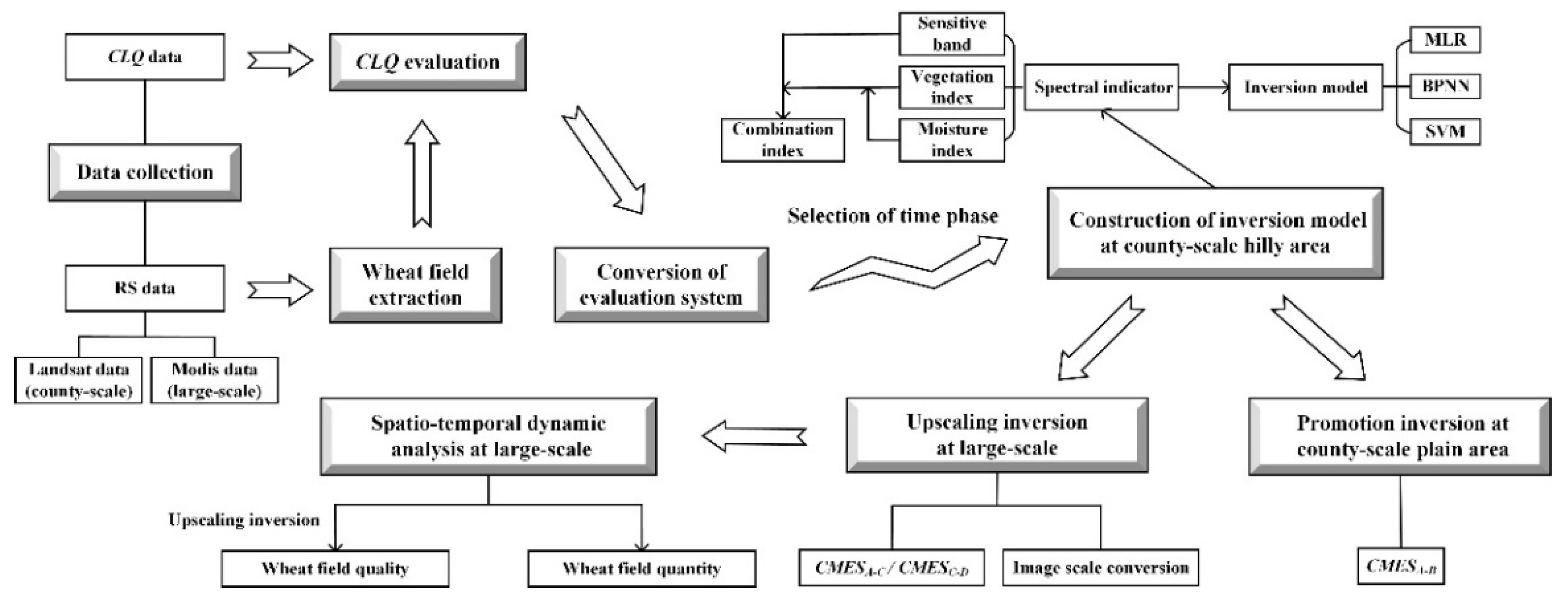
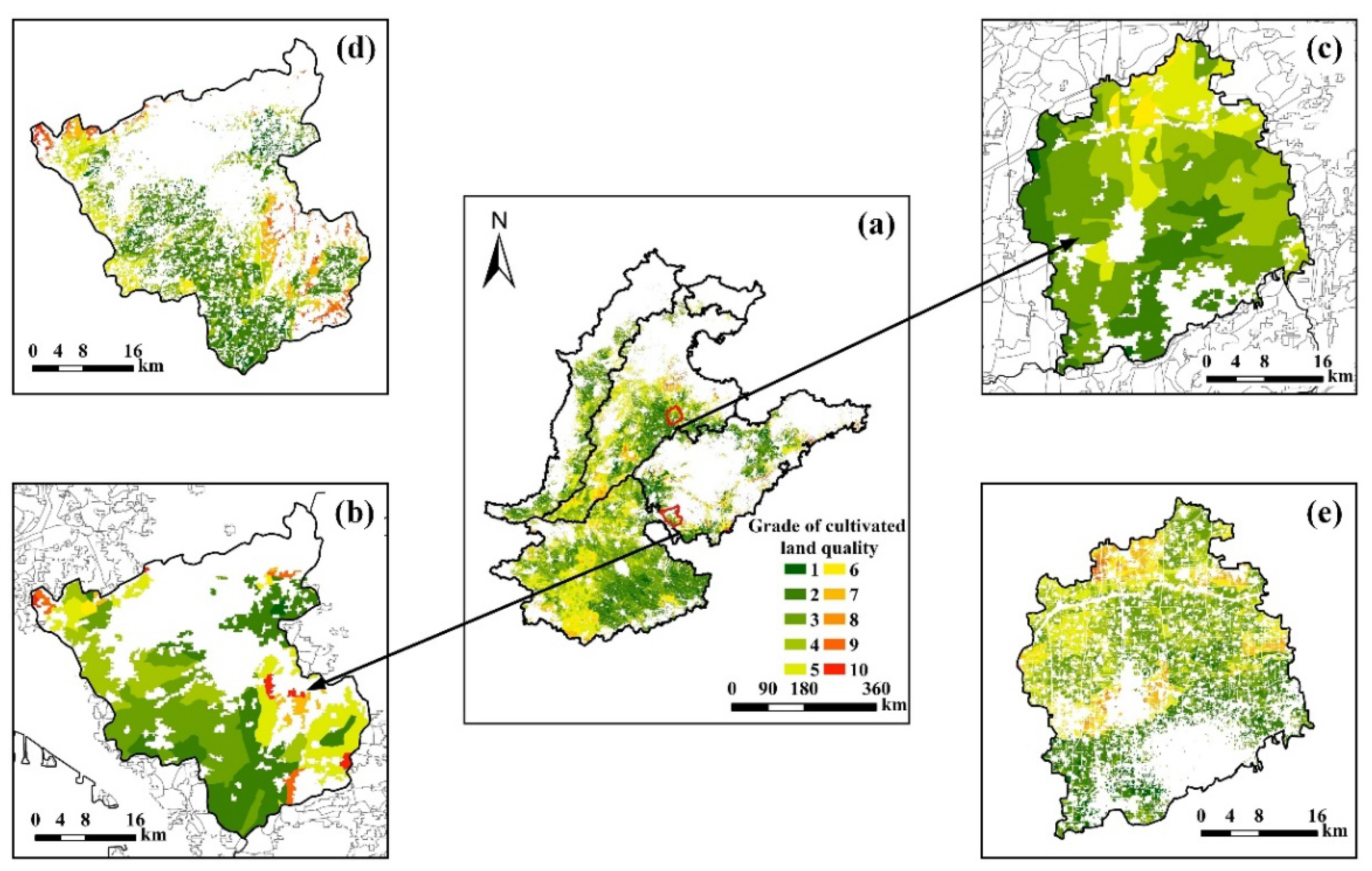

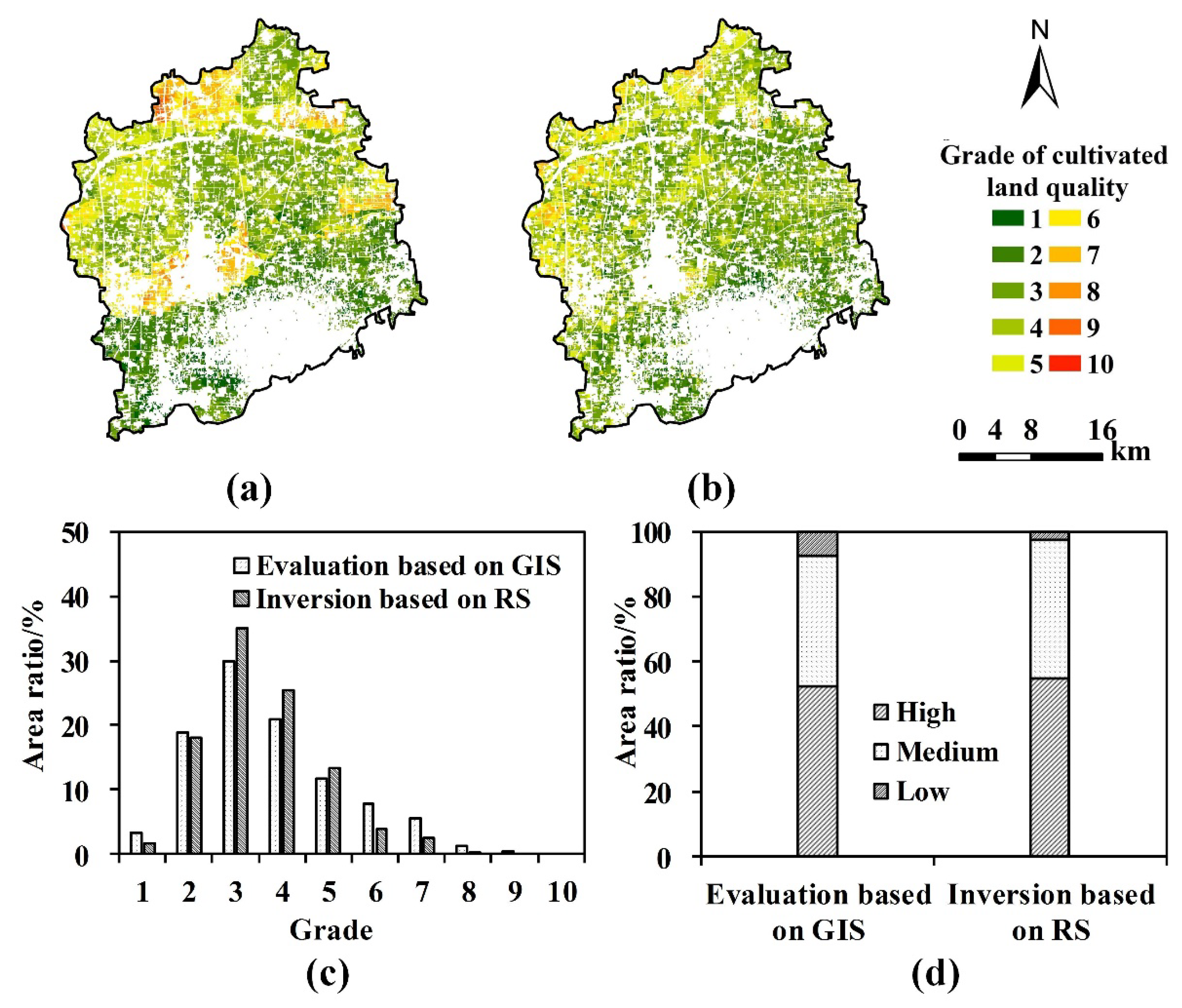
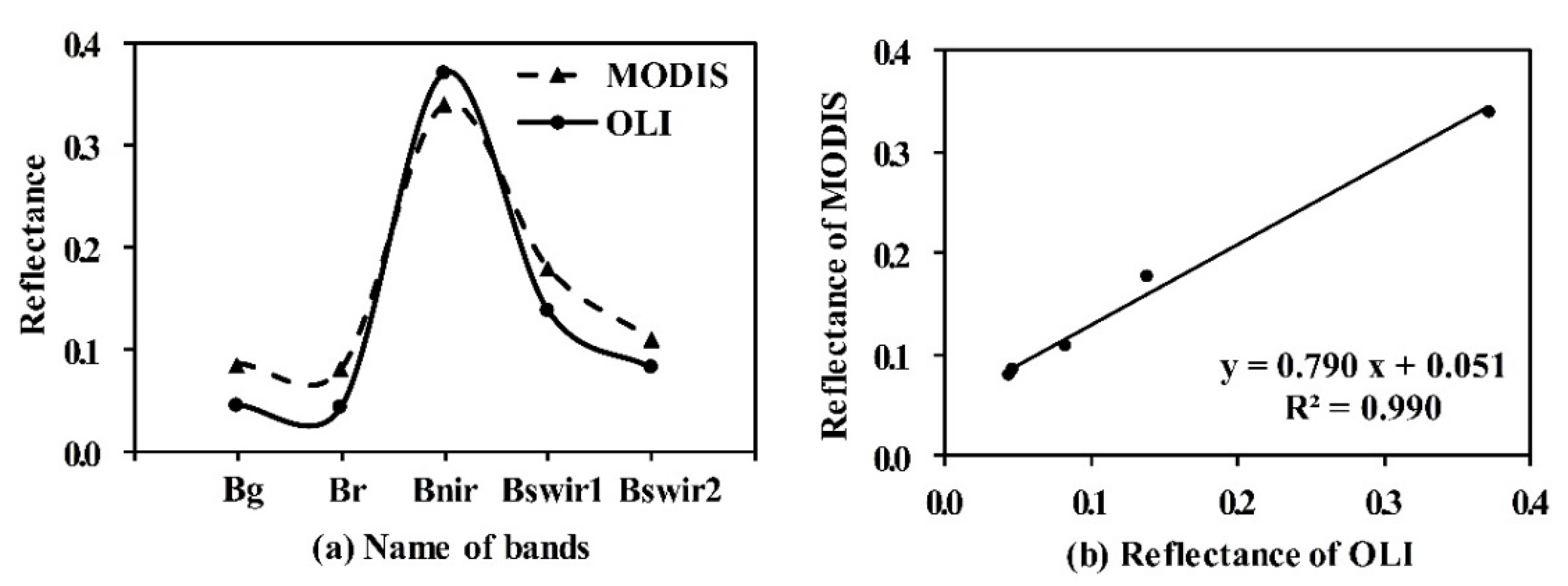

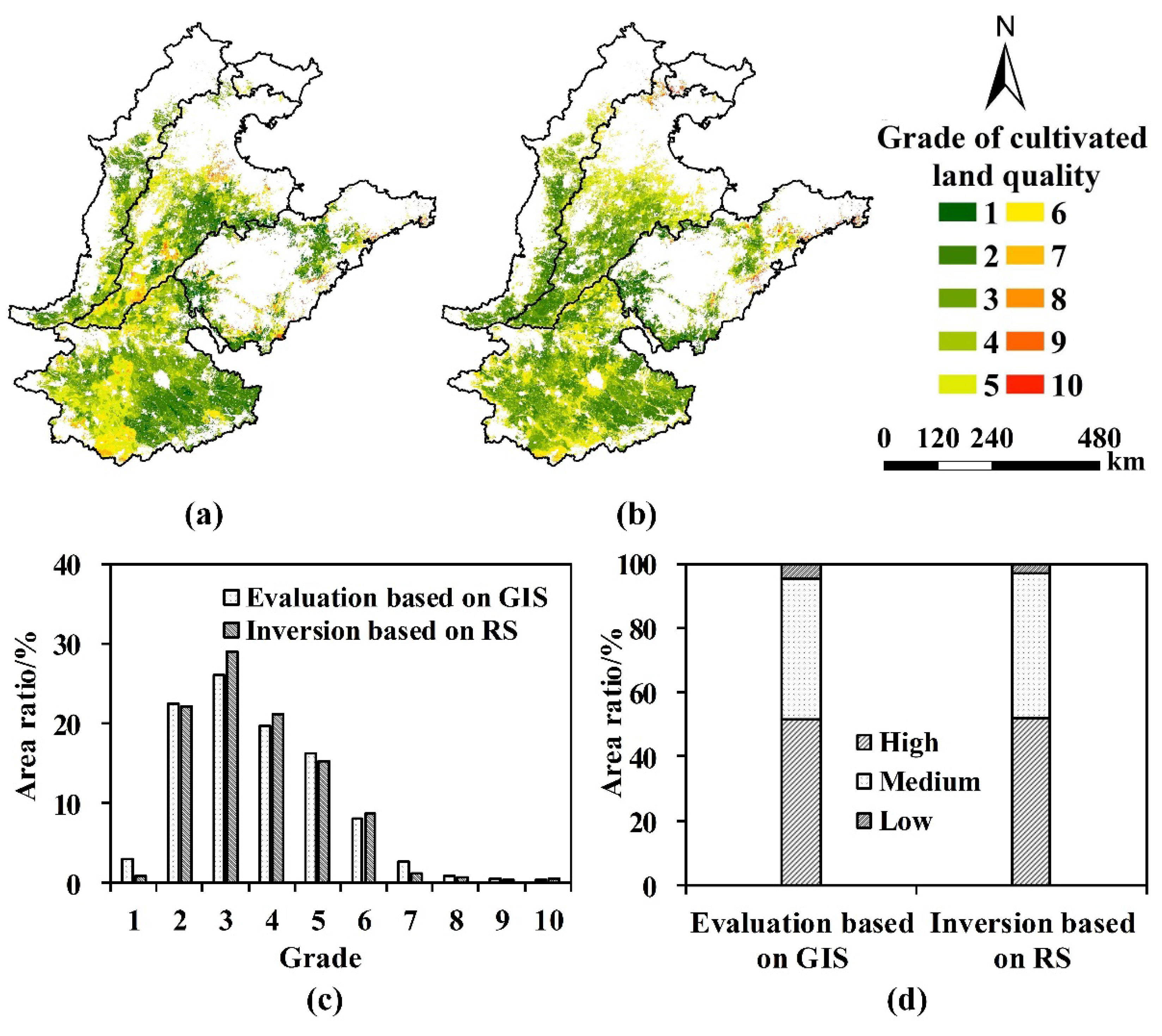
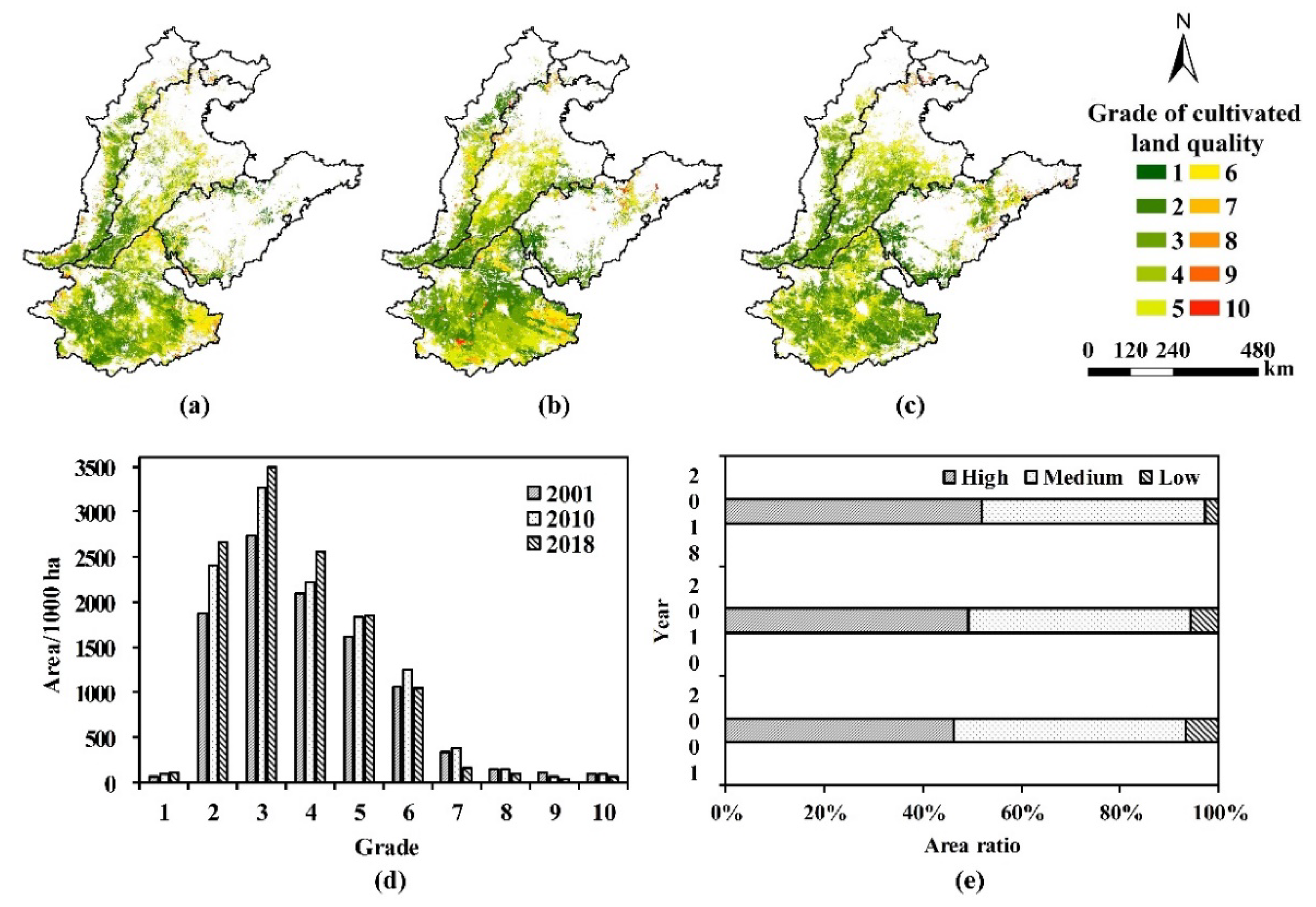
| Spectral Group | Spectral Indicator | R | Spectral Group | Spectral Indicator | R |
|---|---|---|---|---|---|
| Sensitive band group | Coastal | −0.316 ** | Moisture index group | SWCI | 0.613 ** |
| Blue | −0.424 ** | NDMI | 0.743 ** | ||
| Green | −0.524 ** | NDI | 0.736 ** | ||
| Red | −0.646 ** | MSI1 | −0.755 ** | ||
| NIR | 0.706 ** | MSI2 | −0.738 ** | ||
| SWIR1 | −0.511 ** | GVMI | 0.745 ** | ||
| SWIR2 | −0.615 ** | SWIRR | 0.608 ** | ||
| SIWSI | 0.750 ** | ||||
| WI | 0.743 ** | ||||
| Vegetation index group | NDVI | 0.729 ** | Combination index group | ① Green/(NIR-SWIR1) | −0.757 ** |
| RVI | 0.686 ** | ② Red/(NIR*SWIR1) | −0.738 ** | ||
| DVI | 0.743 ** | ③ Red+NIR-SWIR2 | −0.761 ** | ||
| SAVI | 0.761 ** | ④ DVI+NDMI | 0.805 ** | ||
| TVI | 0.745 ** | ⑤ NDVI+SWCI | 0.736 ** | ||
| EVI | 0.754 ** | ⑥ NDVI*MSI2 | −0.745 ** | ||
| ARVI | 0.740 ** | ⑦ MSI2/GRVI | −0.761 ** | ||
| GNDVI | 0.718 ** | ⑧ (NDVI-NDMI)/ (NDVI+NDMI) | −0.750 ** | ||
| GRVI | 0.683 ** |
| Variable Group | Modeling Method | Modeling Set (700) | Validation Set (320) | ||
|---|---|---|---|---|---|
| R2 | RMSE | R2 | RMSE | ||
| Sensitive band group | MLR | 0.579 | 5.982 | 0.569 | 6.297 |
| BPNN | 0.637 | 5.570 | 0.618 | 5.922 | |
| SVM | 0.618 | 5.796 | 0.616 | 5.797 | |
| Vegetation index group | MLR | 0.601 | 5.825 | 0.592 | 6.117 |
| BPNN | 0.658 | 5.399 | 0.630 | 5.852 | |
| SVM | 0.654 | 5.512 | 0.620 | 5.571 | |
| Moisture index group | MLR | 0.601 | 5.824 | 0.631 | 5.829 |
| BPNN | 0.667 | 5.343 | 0.624 | 5.911 | |
| SVM | 0.639 | 5.623 | 0.632 | 5.750 | |
| Combination index group | MLR | 0.673 | 4.994 | 0.640 | 5.041 |
| BPNN | 0.723 | 4.645 | 0.722 | 4.661 | |
| SVM | 0.715 | 4.780 | 0.717 | 4.595 | |
| Name of Bands | Reflectance Conversion Model | R2 | P |
|---|---|---|---|
| Bg | 0.625 | 0.000 | |
| Br | 0.636 | 0.000 | |
| Bnir | 0.651 | 0.000 | |
| Bswir1 | 0.588 | 0.000 | |
| Bswir2 | 0.538 | 0.000 |
Publisher’s Note: MDPI stays neutral with regard to jurisdictional claims in published maps and institutional affiliations. |
© 2021 by the authors. Licensee MDPI, Basel, Switzerland. This article is an open access article distributed under the terms and conditions of the Creative Commons Attribution (CC BY) license (https://creativecommons.org/licenses/by/4.0/).
Share and Cite
Li, Y.; Chang, C.; Wang, Z.; Qi, G.; Dong, C.; Zhao, G. Upscaling Remote Sensing Inversion Model of Wheat Field Cultivated Land Quality in the Huang-Huai-Hai Agricultural Region, China. Remote Sens. 2021, 13, 5095. https://doi.org/10.3390/rs13245095
Li Y, Chang C, Wang Z, Qi G, Dong C, Zhao G. Upscaling Remote Sensing Inversion Model of Wheat Field Cultivated Land Quality in the Huang-Huai-Hai Agricultural Region, China. Remote Sensing. 2021; 13(24):5095. https://doi.org/10.3390/rs13245095
Chicago/Turabian StyleLi, Yinshuai, Chunyan Chang, Zhuoran Wang, Guanghui Qi, Chao Dong, and Gengxing Zhao. 2021. "Upscaling Remote Sensing Inversion Model of Wheat Field Cultivated Land Quality in the Huang-Huai-Hai Agricultural Region, China" Remote Sensing 13, no. 24: 5095. https://doi.org/10.3390/rs13245095
APA StyleLi, Y., Chang, C., Wang, Z., Qi, G., Dong, C., & Zhao, G. (2021). Upscaling Remote Sensing Inversion Model of Wheat Field Cultivated Land Quality in the Huang-Huai-Hai Agricultural Region, China. Remote Sensing, 13(24), 5095. https://doi.org/10.3390/rs13245095




